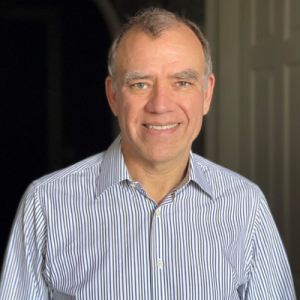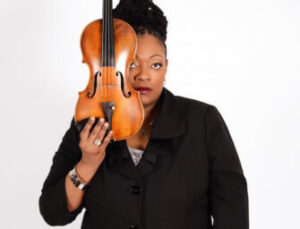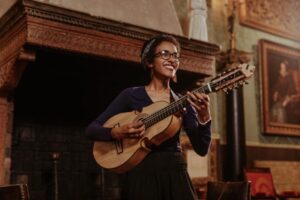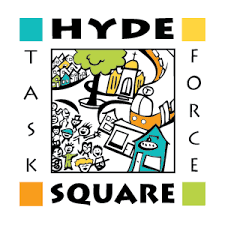Tonight is a tale of two traditions and three soloists.
The program begins with European works from the Classical era, and concludes with music from Latin cultures, including works from Puerto Rico and Spain. Our soloists are virtuosos on three different string instruments: violin, cuatro, and guitar. We extend our appreciation to them for their generous partnering with the Landmarks Orchestra, and for their leadership in Boston’s musical community.
Giacomo Rossini scored an extraordinary success with his opera, The Barber of Seville. By the time of its 1816 premiere, he was already the most performed composer in operatic history. Audiences lapped up his music like champagne, to which his sparkling creations were often compared. He composed The Barber of Seville in just under three weeks. It was his seventeenth opera, out of a catalogue that eventually grew to forty. The Barber of Seville Overture—which he also used in two other operas—was an instant hit and has long since become a cornerstone of the symphonic repertoire.
Mariana Green-Hill has contributed to Boston’s musical scene in extensive and important ways: as soloist, chamber musician, pedagogue, and institutional leader. She has been a featured artist and collaborator with the Boston Landmarks Orchestra for many years, most recently leading the members of the Four Strings Academy at the Hatch Shell on August 2. Tonight, she introduces an important work by a fascinating and unjustly neglected composer.
Joseph Bologne—subject of the 2022 feature-length film Chevalier—was one of the most broadly gifted figures of the 18th century. Born on the Caribbean island of Guadeloupe to a wealthy French planter father and an islander mother whom he enslaved, Joseph was sent to school in Paris at the age of seven. He quickly excelled in virtually everything, including music, dance, horsemanship, and fencing. According to Antoine La Boëssière’s 1818 treatise on fencing, “At fifteen [Bologne’s] progress was so rapid, that he was already beating the best swordsmen, and at seventeen developed the greatest speed imaginable.” Winning a contest against a renowned master, Bologne was appointed gendarme in the royal guard by King Louis XVI. He assumed his father’s noble suffix, becoming the “Chevalier de Saint-Georges.” Bologne was also one of the greatest violinists of his day. Among other honors, in 1773 he assumed the directorship of the Concert des Amateurs, one of the leading orchestras in Europe. His compositions include chamber music, concertos, symphonies, and stage works, many of which, including his Violin Concerto G major, were for his own use as soloist. His performances were said to astound and enrapture the public. When the French Revolution erupted, Bologne’s ties to the court—including his closeness to Marie-Antoinette—were subject to scrutiny and litigation, serving to undermine his later career.
When Wolfgang Amadè Mozart needed a symphonic work to introduce in Vienna on short notice, he wrote to his father in Salzburg, requesting that he send a serenade composed a few months earlier for a ceremony elevating his friend, Sigmund Haffner, to the nobility. When the score arrived in the post, Mozart was astonished at its quality, and didn’t recall a note of it, he had composed it in such haste. He had written the serenade for entertainment purposes, as background music. But for the Viennese he needed a concert work, so he refashioned the serenade as a symphony, making it both grander and more compact. He dropped two movements—an opening march and one of two minuets—and added flutes and clarinets. The opening gesture of the first movement of Symphony No. 35 “Haffner”—with its two-octave leap and athletic rhythms—sets the tone for the whole symphony, a work of power and vigor. The second and third movements combine a constantly pulsing vitality with Mozart’s most lyrical symphonic writing to date. The final movement, marked Presto, foreshadows the dazzling bustle of his overture to the Marriage of Figaro. When Mozart sent the original serenade to his father, he had included an instruction that the finale should be played “as fast as possible.”
Puerto Rican-born composer Roberto Sierra was elected to the American Academy of Arts and Letters in 2021. In 2017, he was awarded the Tomás Luis de Victoria Prize, the highest honor given in Spain to a composer of Spanish or Latin American origin. His works have been commissioned and performed by orchestras and ensembles all over the world, including the Boston Symphony, Philadelphia Orchestra, the New York Philharmonic, the Tonhalle Orchestra of Zurich, the St. Lawrence String Quartet, and many others. Guaracha is the fifth and final movement of his Serenata, a work blending elements of the 18th and 19th-century dance suite with Latin American rhythms and contemporary harmonies. The guaracha originated in Cuba, but soon became popular in Puerto Rico, where it assumed its own national character. The dance is always celebratory and playful. Sierra’s setting evokes childhood parties, with ebullient interactions occasionally disrupted by gleeful chaos.
Fabiola Méndez—the renowned Puerto Rican cuatro player, singer, and composer—is gifted with tremendous musical versatility. Her musical roots are in both Puerto Rico and Boston. Though still in her twenties, she is already a revered performer. Her recordings on the cuatro have drawn raves and awards from around the world. She opens with two works tonight, both Puerto Rican folk tunes. Here is her description of them:
Aguinaldo Orocoveño
“An aguinaldo is a gift. This is a folk piece from Puerto Rico that is traditionally played to start festivities, especially around the holidays (music symbolizing the gift musicians offer to their communities). This particular melody is from the center region of Puerto Rico, in a town called Orocovis—hence the title, Aguinaldo Orocoveño.”
Seis Chorreao
“The seis is another traditional form of Puerto Rican folk music. There are more than one hundred and fifty variations of seises in Puerto Rico. Each one is characterized by a main melody, from which cuatristas take inspiration to improvise and create a variation of lines throughout the whole piece. The Seis Chorreao is one of the fastest seises, creating an opportunity for the cuatrista to play fast scales up and down the neck of the instrument, and for audiences to dance along.”
[Maestro Zone and young dancers: take note!]
Tonight’s concert is the culmination of an extended residency led by Fabiola Méndez, the Boston Landmarks Orchestra, and the Hyde Square Task Force in Jamaica Plain. The mission of the Hyde Square Task Force is to “amplify the power, creativity, and voices of youth, connecting them to Afro-Latin culture and heritage so they can create a diverse, vibrant Latin Quarter, and build a just, equitable Boston.” The residency was developed in collaboration with Ágora Cultural Architects—and co-founder Elsa Mosquera Sterenberg—a consulting group that increases Latinx cultural visibility through the arts.
Fabiola Méndez’s set concludes with a new work that has grown out of the residency. It is a song co-written by Fabiola, six students from the Hyde Square Task Force, and composer-orchestrator David Kempers. All co-composers perform tonight alongside the professionals, and dancers from the same program join as well. Here Fabiola Méndez describes the work, and the process that led to its creation:
“A través de las aguas (“Through the Waters”) is a call for unity within Latinxs and beyond. The students of the Hyde Square Task Force wanted to develop the lyrics thinking about the water element as a force that connects us all.
“The first verse (in Spanish) is an invitation to leave our differences behind and unite across the water to sing. Then the humming chant comes in, simulating the feel of water flowing—a unifying melody inviting all to sing along. The bridge of the song mentions the many different countries that represent what Latin America is—it’s like a calling for them all to “join” us. The second verse (in English) is similar to the first, but it connects to our identity and language as Americans, represented in the bluesy feel of that first half of the song. When we get to the chorus, it’s all about the joy and the celebration of sharing who we are with one another. “
 CHRISTOPHER WILKINS was appointed Music Director of the Boston Landmarks Orchestra in the spring of 2011. Since then, he has expanded the orchestra’s mission of making great music accessible to the whole community. He has also helped develop the orchestra’s Breaking Down Barriers initiative, making accessibility a priority in all aspects of the orchestra’s activities.
CHRISTOPHER WILKINS was appointed Music Director of the Boston Landmarks Orchestra in the spring of 2011. Since then, he has expanded the orchestra’s mission of making great music accessible to the whole community. He has also helped develop the orchestra’s Breaking Down Barriers initiative, making accessibility a priority in all aspects of the orchestra’s activities.




